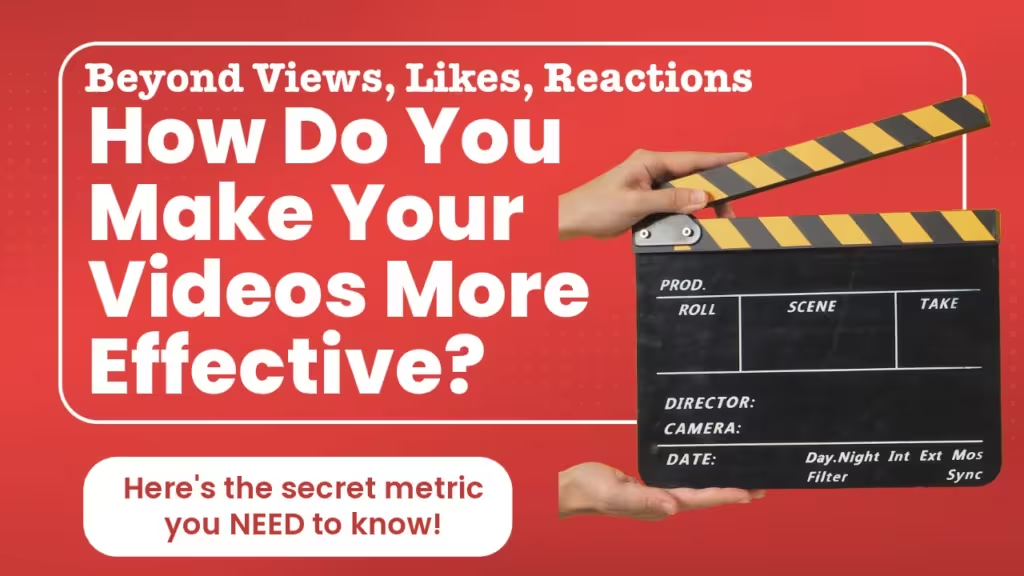When you want to create effective videos for marketing, the real challenge isn’t just producing great content.
Many video and marketing agencies talk about videos driving engagement for your audience. But “Engagement” is a vague term that means very little to the bottom line.
So how do you really know if any video you make is working or effective?
It’s in understanding how that content is viewed by the audience and making data-driven improvements.
While likes and views can give you a surface-level understanding, they don’t tell the full story. If you’re serious about driving real results—whether that’s increasing sales, generating leads, or building brand awareness—then you need to dive deeper.
That’s where Retention Rate Analysis, the most reliable way to measure and refine your video’s effectiveness, comes in.
Pro Tip: It is very important that you first need to have a good marketing and content distribution strategy. Otherwise none of these data will provide a useful metric.
Remember, if no one is watching your videos, then that is the first problem you have to solve.
Why Retention Rate is Your Most Valuable Metric to Create Effective Videos
Retention rate tells you how much of your video your audience is actually watching. Are they sticking with your content until the end, or are they dropping off halfway through? Understanding this helps you identify exactly where viewers lose interest, so you can pinpoint what’s working—and more importantly, what’s not. It is the real secret to help create effective videos.
Sure, views tell you how many people started watching, but retention tells you how many stayed engaged. And that’s the difference between a video that captures attention and a video that actually drives results; and ROI.
How to Use Retention Rate Data to Improve Your Videos
Once you’ve uploaded your video to platforms like YouTube or Vimeo, you’ll gain access to detailed analytics about how your viewers are interacting with your content. Here’s how to make the most of retention rate analysis:
1. Identify Key Drop-off Points
One of the most valuable insights retention rate offers is the exact moments when viewers stop watching your video. If a significant percentage of your audience is leaving after the first 10 seconds, that’s a big red flag. It means your opening—also known as your hook—isn’t grabbing their attention. In this case, revisiting how you’re introducing your content could be the key to keeping viewers engaged longer.
But what if people are dropping off midway through? This could indicate a disconnect between your hook and the rest of your story. Your introduction might be promising something exciting, but if the middle section doesn’t deliver on that promise, viewers will lose interest.
The solution? Make sure your video flows smoothly from one point to the next, and that every part of the story aligns with the expectations you set early on.
2. Evaluate the Effectiveness of Your Call-to-Action (CTA)
What if your retention rate shows that most viewers are watching your video all the way to the end, but your call-to-action isn’t converting? In this case, it’s time to evaluate whether your CTA is clear, compelling, and relevant to your audience. If viewers don’t know what you want them to do—or worse, if they don’t see the value in taking that action—they won’t follow through.
For example, if your video is about a specific product, but your CTA is to sign up for a newsletter, that’s a mismatch. Instead, your CTA should directly align with the message of your video, making it easy for viewers to understand the next step you want them to take.
3. Test Different Formats and Messages
Retention rate analysis also allows you to experiment with different formats and messaging. Not all audiences respond to the same style of content, so testing variations can help you find what resonates most with your viewers. If you notice a certain type of video has a consistently higher retention rate, it’s a good indicator that you should create more content in that style.
The beauty of platforms like YouTube and Vimeo is that they make it easy to upload and test different versions of the same video. You can tweak small elements like the opening, the pacing, or even the CTA, and track how these changes impact your retention rate.
The Power of Retention Rate Analysis
To create effective videos, it isn’t just about looking good—it’s about delivering results. And the most reliable way to measure those results is by analyzing your retention rate. This method gives you actionable insights into what’s working, what’s not, and how you can continuously improve your video content to meet your business goals.
By understanding where viewers drop off, tweaking your messaging, and refining your CTA, you can turn an underperforming video into a powerful marketing tool that not only engages but converts.
So, ready to start analyzing your video retention rates? The data is waiting—it’s up to you to use it.




